Crested Geckos (Correlophus ciliatus) are an arboreal reptile species distinguished by the delicate, eyelash-like crests that extend from above the eyes down their back (13). This small lizard is a member of the family Diplodactylidae, a lineage of geckos found predominantly in Oceania and Australia, and is classified within the order Squamata (4,11). Adults typically reach a total length of 8 to 10 inches (20 to 25 cm) and weigh between 1.2 and 2.1 ounces (35 to 60 grams) (5). This species is endemic to the tropical rainforests of New Caledonia, where it exists in three isolated populations on Grande Terre and the Isle of Pines (1,6). The species is listed as Vulnerable by the IUCN due to threats like habitat loss and invasive species (2,10).
This guide provides a scientific overview of the crested gecko’s biology, examining its physical adaptations, life cycle, and unique morphological traits (10). We will also analyze the species’ natural behaviors and its role within the ecosystem of its native habitat, including the conservation challenges it faces (1,6). To begin our journey into this remarkable creature’s world, what exactly are crested geckos?
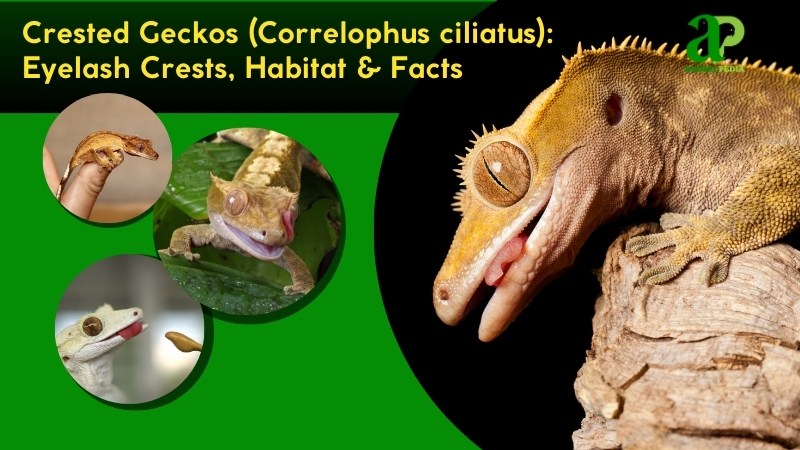
What Are Crested Geckos?
The crested gecko, or eyelash gecko, is a small, nocturnal lizard from the tropical rainforests of New Caledonia, noted for the distinctive fringed crests over its eyes and along its spine (6). This species belongs to the Animalia kingdom, Reptilia class, and the order Squamata (4,11). Within this classification, it resides in the family Diplodactylidae, a group of geckos primarily found in Australia and Oceania (5). The scientific name, Correlophus ciliatus, reflects its defining features; the specific epithet ciliatus comes from the Latin word for “eyelash,” referencing its crests (1,6). The species was first documented in 1866 but was later believed extinct until its rediscovery in 1994 during a research expedition led by German herpetologist Robert Seipp (1,8).
A reclassification in 2012 moved the species from the genus Rhacodactylus to the current genus, Correlophus, following a comprehensive phylogenetic study of New Caledonian geckos (2). This change was based on genetic analysis distinguishing the crested gecko from its relatives. While the IUCN lists Correlophus ciliatus as Vulnerable due to habitat loss and invasive predators, some herpetologists argue its status should be re-evaluated (1,9). Opposing views suggest its ability to thrive in captivity demonstrates a resilience that may offset some conservation concerns, though this perspective is not universally held and does not diminish the threats faced by wild populations. With a clear understanding of its origins, what physical characteristics make this species so unique?
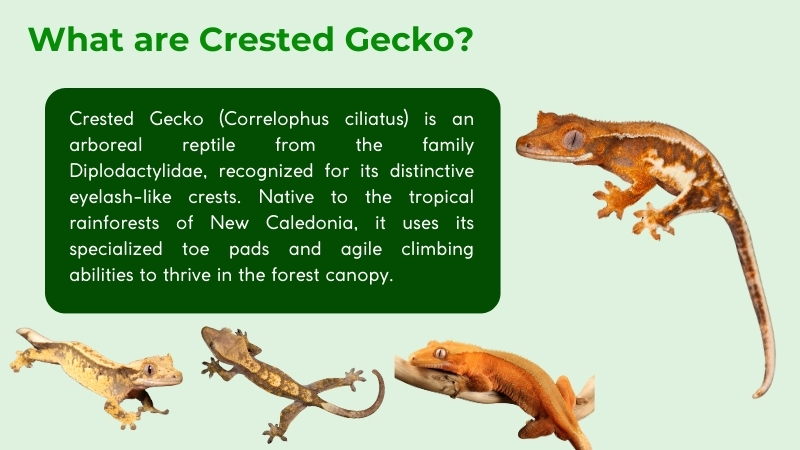
What Do Crested Geckos Look Like?
The crested gecko has a slender, arboreal physique, which is suited for climbing and moving through its native rainforest canopy (5). The skin is soft and velvety, which helps with camouflage among foliage (5). Crested geckos have a wide range of colors, including grey, brown, red, orange, yellow, and cream (6,7). Patterns vary from patternless to white-fringed, tiger-striped, or spotted (6). A curious characteristic is their ability to change color, becoming more vibrant at night (“fired up”) and duller during the day (“fired down”) (7). These color changes correlate with mood, humidity, or temperature (6).
This species has a number of unique features that contribute to its distinctive appearance and survival. These anatomical traits include specialized feet, a wedge-shaped head, and a unique tail structure (5).
- Eyelash-like Crests: The most recognizable feature is the eyelash-like crests extending over the eyes and along the back, which give the species its name (1,6). These hair-like structures may function as sensory organs or provide protection for the eyes (5).
- Lidless Eyes: Crested geckos possess large eyes with slit-shaped pupils, which are adapted for nocturnal vision (13). They lack eyelids and use their long, flat tongues to clean the transparent spectacle scale that covers each eye, a behavior often observed in this species (6,13).
- Adhesive Limbs and Toes: The slender legs have specialized webbed toes covered with microscopic hairs known as setae, which split into smaller spatulae (1,6). This structure allows them to grip smooth surfaces like glass via van der Waals forces, while small claws assist in climbing rougher textures (1).
- Semi-prehensile Tail: The semi-prehensile tail is used for balance and climbing (13). It is capable of caudal autotomy, a defense mechanism where the gecko detaches its tail to distract a predator (1). The tail does not regenerate, which is a key reason why most wild adults are tailless (1).
When examining crested geckos, sexual dimorphism is present, though subtle. Male geckos can be identified by a visible hemipenal bulge at the base of the tail, which appears around 3 to 4 months of age (4). This feature is absent in females (4). Males may also have slightly broader heads (4). Having explored their unique morphology, how large can these geckos actually grow?
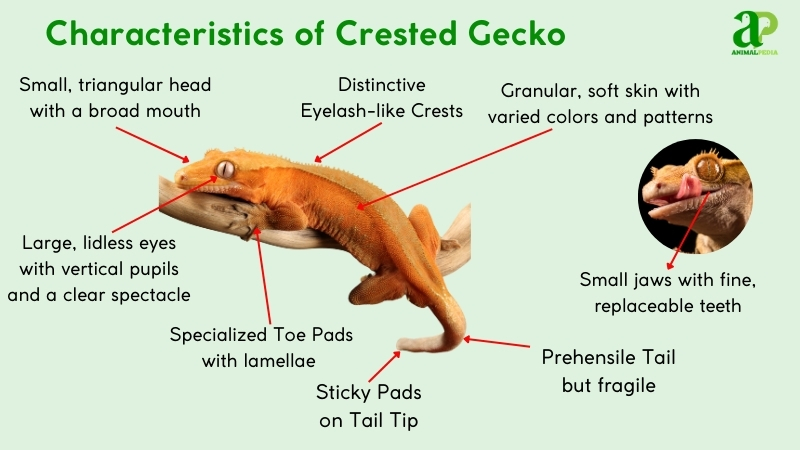
How Big Are Crested Geckos?
Adult crested geckos typically reach a length of 8 to 10 inches (20 to 25 cm), including their tail, and weigh around 1.2 to 2.1 ounces (35 to 60 grams) (5). They undergo distinct growth stages. Hatchlings are small, measuring 2 to 3 inches (5 to 7.6 cm) and weighing just 0.03 to 0.07 ounces (1 to 2 grams) (12). Juveniles grow rapidly, often reaching sexual maturity at a weight of 1.2 ounces (35 grams) and an age of 12 to 15 months (4).
For perspective, a full-grown crested gecko is approximately the length of a standard pen or pencil. The size difference between genders is minimal, but females can be slightly heavier due to egg production. Now that we have a measure of their size, what tropical habitat do they call home?
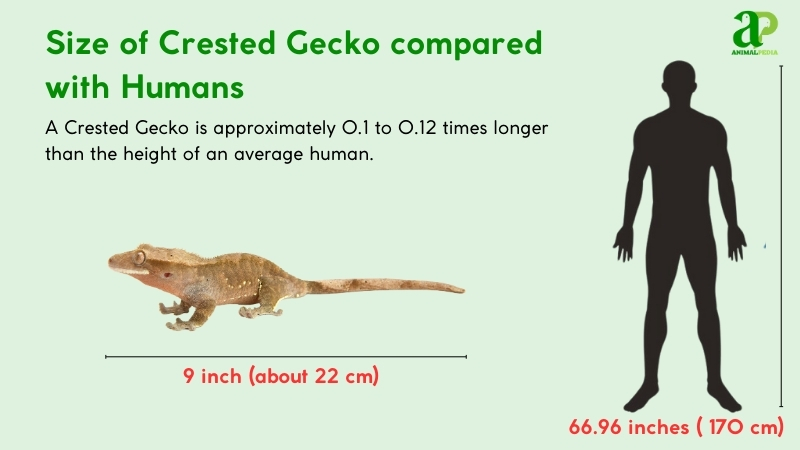
Where Do Crested Geckos Live?
Crested geckos are endemic to the tropical rainforests of New Caledonia, an archipelago in the South Pacific (1,6). This arboreal species lives in the forest canopy, a habitat characterized by dense vegetation and a warm, humid climate (5).
Their geographic range includes three isolated populations on Grande Terre, the main island, and one on the Isle of Pines (1). They are primarily nocturnal, spending daylight hours camouflaged among the foliage. Their unique physical adaptations, such as their adhesive toe pads, make them skilled climbers, allowing them to navigate their treetop environment effectively (1,5). Within their native habitat, what unique behaviors do these geckos exhibit to survive?
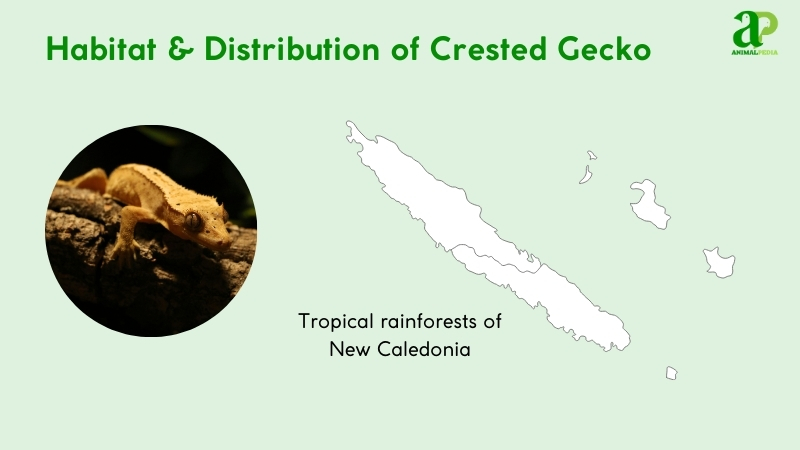
How Do Crested Geckos Behave?
Crested geckos exhibit a range of behaviors centered around their nocturnal, arboreal lifestyle and dietary needs. These behaviors include specialized feeding, movement, and a consistent daily activity cycle. A closer examination of these behaviors reveals the gecko’s specialized adaptations for survival.
Diet and Feeding
Crested geckos are omnivorous, feeding on a combination of insects and fruit pulp in their natural habitat (4,6). Their diet is not specialized; they are opportunistic feeders that consume a variety of small arthropods, including crickets, roaches, and various insect larvae (4). This adaptability contributes to their success both in the wild and in captivity. Crested geckos typically hunt with a sit-and-wait approach, remaining motionless before making a quick lunge to capture prey (1,6). Their feeding patterns are most active at night when they forage for food. They use their long tongues to lap up nectar and soft fruit (4). There is no evidence of them being active predators that chase their prey over long distances. What about their movement and agility?
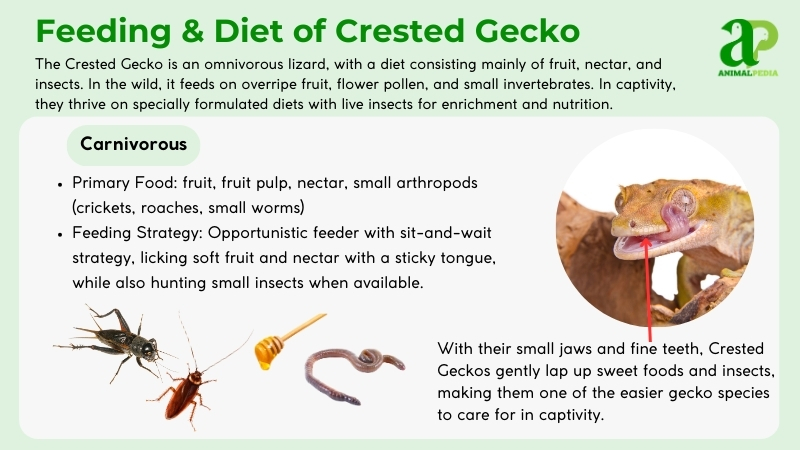
Movement and Abilities
Crested geckos are agile climbers, navigating their arboreal environment with a deliberate and controlled movement (5,13). They move vertically with ease, scaling tree trunks and branches using their specialized toe pads (1). The species is also known for its leaping ability, capable of jumping horizontally between branches (5,6). This agility is a primary mode of moving between trees, showcasing a burst of speed rather than sustained running (5). Their unique abilities stem from several physical adaptations. The adhesive toe pads, covered in microscopic setae, provide incredible grip on smooth surfaces (1,6). A prehensile tail acts as a fifth limb for grasping and balancing, and is a critical tool for stability and climbing (13). While the species does not reach high speeds, its ability to navigate a vertical landscape with precision is a key survival trait. What is their daily routine like in the wild?
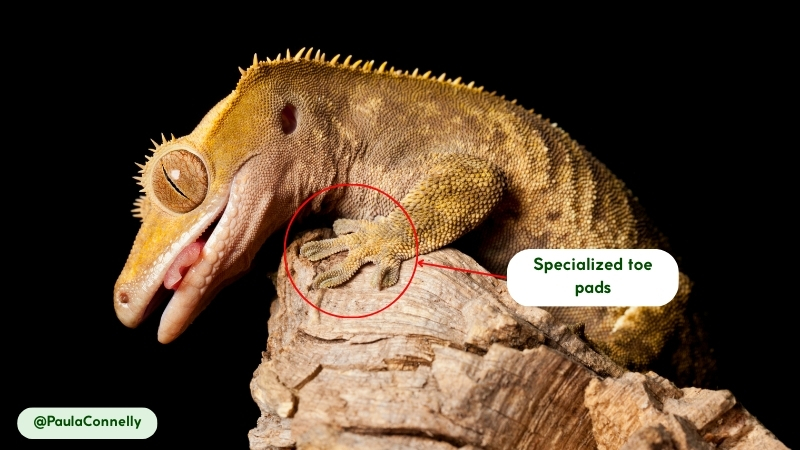
Daily/Seasonal Patterns
Crested geckos are nocturnal animals, with their activity cycle beginning after dusk and ending before dawn (6,13). They spend the daylight hours sleeping, often camouflaged among leaves or inside tree hollows to avoid predators (1). Their daily activity is a simple cycle. They remain inactive during the day, becoming active in the evening to hunt and forage (1,6). This pattern is consistent year-round, as they live in a stable tropical climate without extreme seasonal temperature changes that would necessitate hibernation (5). Unlike many other reptile species, crested geckos do not have a defined migration period. They remain within a relatively small territory in their native habitat (1). Their activity may slightly increase during the wet season due to a greater abundance of food and favorable humidity levels, but this does not constitute migration (5). With an understanding of their daily lives, what biological processes govern their reproduction?
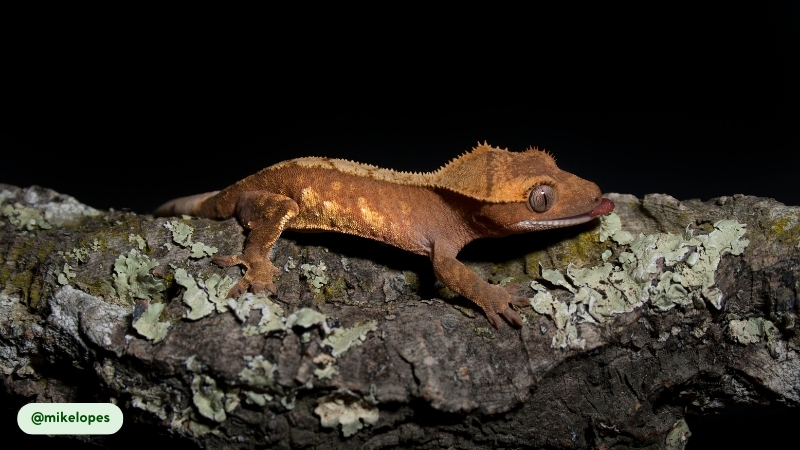
How Do Crested Geckos Reproduce?
Crested geckos are oviparous, a reproductive method involving the laying of eggs (4,12). Their breeding season typically occurs during the warmer, more humid months, from spring through summer (4). During courtship, a male crested gecko will exhibit a series of head bobs and tail wags to approach a female (12). After mating, a female can retain sperm for several clutches (4).
Females lay one or two eggs per clutch, with clutches spaced 30 to 45 days apart during the breeding season (12). Eggs are typically deposited in a soft substrate (12). The incubation period is temperature-dependent, usually ranging from 60 to 150 days (4,12). This species does not provide parental care; the hatchlings are independent upon emergence (12). The reproductive cycle is key to their population, but how long can a crested gecko live?
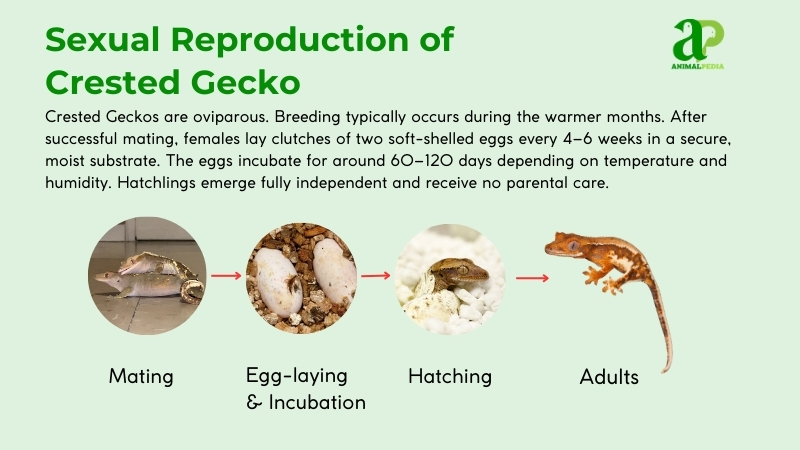
How Long Do Crested Geckos Live?
Crested geckos typically live around 15 to 20 years in captivity, a greater lifespan than wild geckos (4,12). In their natural habitat, geckos face predation and inconsistent resources (1,6). Captive individuals benefit from controlled environments with consistent temperatures, a balanced diet, and no predators. Their longevity is influenced by these factors, including a controlled diet and an absence of environmental stressors (12). This species reaches sexual maturity at 12 to 15 months of age, or when it attains a body weight of about 1.2 ounces (35 grams) (4). This rapid growth allows them to reproduce early in their extended life. Considering their longevity, what role do crested geckos play in human society?
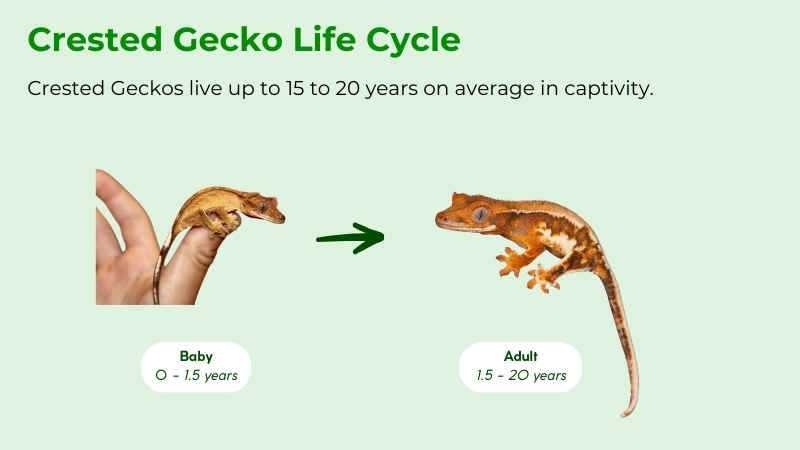
Are Crested Geckos Beneficial to Humans?
Crested geckos are beneficial to humans; their docile nature and small size make them a beneficial species (4,12). These lizards lack venom and do not possess aggressive behaviors, and bites are rare (1). In the wild, their primary role is as a predator of insects, including arthropods that may be considered pests (4). This makes them a natural contributor to the balance of their tropical ecosystem (1).
As a widely kept pet, the crested gecko provides significant benefits to humans by serving as an educational animal (12). Their simple care requirements and calm temperament make them ideal for study and observation, fostering an interest in herpetology (12). They do not have a documented history of cultural significance but are valued for their role in scientific research and for providing a gateway into wildlife appreciation (1). While they are beneficial to humans, what threats do these geckos face in the wild?
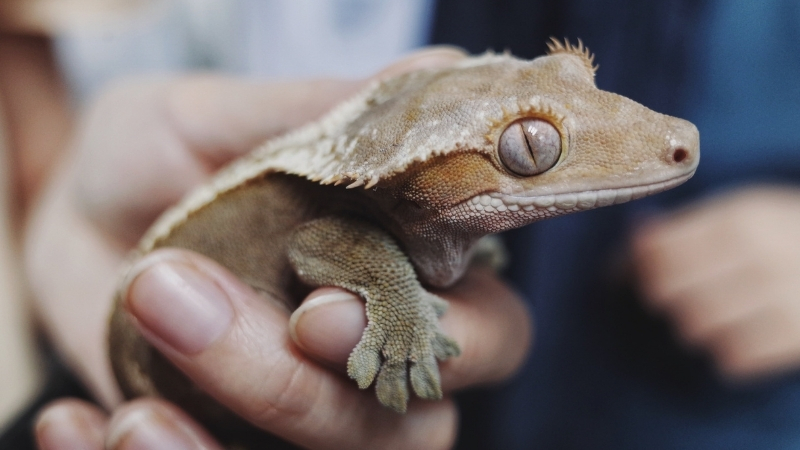
Are Crested Geckos Endangered?
Crested geckos are listed as a Vulnerable species on the IUCN Red List (2,10). Their limited population and distribution on New Caledonia make them sensitive to environmental changes (1,6). The primary threats to their survival are habitat destruction from nickel mining and agricultural expansion, and predation from introduced species such as feral pigs, cats, and the little fire ant, a highly invasive insect that preys on gecko eggs and hatchlings (1).
Despite their popularity in the pet trade, the wild population faces significant challenges. Their ecological importance lies in their role as a consumer of insects and as a seed disperser for various plants (4,6). Individual conservation efforts, such as supporting organizations dedicated to preserving New Caledonian rainforests and practicing responsible pet ownership to prevent releases, are key to protecting this species in its native habitat. Despite the conservation challenges, the crested gecko remains a creature of remarkable facts and abilities. What else is there to know about them?
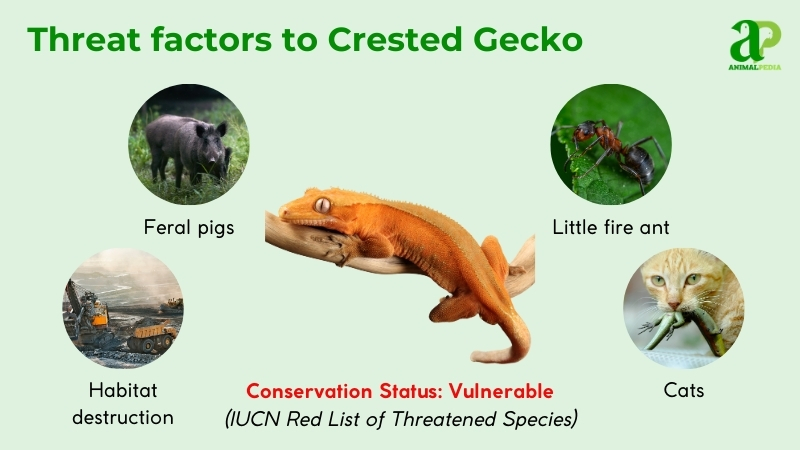
Frequently Asked Questions About Crested Geckos
Are Crested Geckos Nocturnal?
Crested geckos are strictly nocturnal, becoming active at dusk and resting during the day (6,13). They spend daylight hours camouflaged in the foliage, with their activity levels primarily tied to temperature and humidity cycles (5).
How Often Do Crested Geckos Shed?
Crested geckos shed every one to four weeks, with younger geckos shedding more often (12). They often consume their shed skin, a behavior that reclaims nutrients from the epidermis, making the process rarely observed (3).
Do Crested Geckos Hibernate?
Crested geckos do not hibernate. In their native tropical climate, there is no need to enter a state of brumation, a cold-induced dormancy seen in some temperate reptiles (1,5).
Can Crested Geckos See In The Dark?
Crested geckos possess exceptional night vision, allowing them to navigate and hunt in low-light conditions (1,13). Their large eyes with vertical pupils are specialized for maximizing light intake at night.
What Temperature Do Crested Geckos Need?
The thermal gradient for crested geckos should be between 72° to 78°F (22° to 25.5°C) during the day and can drop to 65°F (18°C) at night (4,12). Temperatures outside this range can cause stress.
Why Do Crested Geckos Drop Their Tails?
Crested geckos drop their tails as a defense mechanism against predators (1,13). This behavior, known as caudal autotomy, allows them to escape by distracting a threat with the wiggling, detached tail (1,6).
Conclusion
The crested gecko stands as a unique case of biological adaptation, perfectly suited to its distinctive island habitat. From their specialized toe pads and eyelash-like crests to their nocturnal habits and fascinating vocalizations, these creatures hold a special place in the world of zoology. While their wild populations face challenges from habitat loss, their prevalence in captivity provides a pathway for education and appreciation. At Animal Pedia, our mission is to provide you with a comprehensive understanding of animal life through visual and scientifically accurate content. We hope this guide has deepened your appreciation for the crested gecko. For more scientific insights into the natural world, explore our extensive digital encyclopedia.




